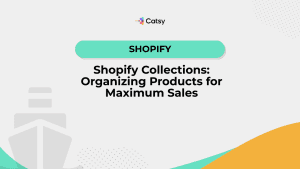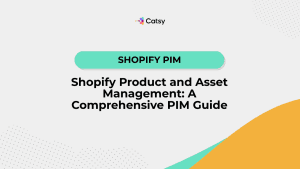Shopify PIM Integrations You Didn’t Know You Needed
In this guide, we’ll map out each of the critical Shopify integrations you didn’t know you needed! Then, we’ll explain how Catsy can help you leverage them.

Table of Contents
- Introduction
- Why Integrations Matter for Shopify PIM
- Core Integrations You Already Know
- Lesser-Known but Powerful Integration
- How Catsy Makes Integration Seamless
- Choosing the Right PIM Integration Strategy
- Conclusion
What You Will Learn:
- Why integrations supercharge your Shopify PIM experience
- Top lesser-known tools to connect for maximum ROI
- Real-world use cases and benefits of each integration
- How Catsy acts as the compass guiding your integrations
- Tips to create a future-proof integration strategy
In this Article
1. Introduction
Running a Shopify store without a solid integration system is like navigating open waters with no compass. Eventually, you’re going to drift off course.
Many e-commerce brands are familiar with the basic Shopify-PIM connection. But few realize the value of connecting a PIM with their broader tech stack. ERP, CRM, marketing tools – these should all be integrated into your product information management strategy.
In this guide, we’ll map out each of the critical Shopify integrations you didn’t know you needed! Then, we’ll explain how Catsy can help you leverage them.
2. Why Integrations Matter for Shopify PIM
Your PIM system does more than just centralize your data. It’s all about mobilizing that data across each of your channels. Integrations will turn your PIM into a single source of truth, allowing data to flow easily into every business-critical system.
The result?
- Streamlined operations
- Improved product time-to-market
- Consistent product content across touchpoints
- Elimination of manual data entry and duplication
According to Forrester, integrated commerce stacks can improve productivity by 30 percent and increase customer satisfaction by 20 percent. That kind of ROI doesn’t happen in isolation; you need the right connections.
Make Catsy DAM and PIM Software an Extension of Your Team
Book a Free Demo3. Core Integrations You Already Know
a. Shopify & PIM: A Vital Sync
At the helm of any e-commerce strategy is the Shopify platform itself. A direct integration between Shopify and your PIM will ensure that your listings are always up to date. Optimized content and standardized data are now the norm.
Key benefits include:
- Real-time product syncs
- Automated categorization and tagging
- Multichannel publishing (such as Shopify Plus, POS)
b. DAM Integration
Your product images, videos, manuals, and 3D assets deserve as much play time as your specs get. That’s why you need a Digital Asset Management (DAM) system.
Integrating your DAM with your PIM makes it easy to associate the right media with the right products. Push these listings to Shopify automatically to maintain brand consistency, no matter where your shoppers find you.
4. Lesser-Known but Powerful Integrations
Let’s drop anchor for a moment as we explore some of the lesser-known integrations with Shopify. These tools will help you sail beyond listings into business-wide optimization.
a. ERP Systems (Netsuite, Acumatica)
Enterprise Resource Planning (ERP) tools are invaluable for inventory, order management, and your financials. But if your product data isn’t synced from your PIM, your ERP may be rendered useless.
Integration Perks:
- Sync your stock levels and warehouse data back to Shopify
- Use centralized SKUs across your purchasing, logistics, and sales operations
- Align your supply chain operations with accurate product info
Example Use Case:
A business-to-business brand using SAP can connect Catsy to ensure up to date pricing and packaging details, based on supplier input. Thousands of SKUs can be automatically populated in Shopify with the correct data.
b. CRM Platforms (Salesforce, HubSpot)
Product data isn’t just for shoppers! Sales reps, account managers, and customer service agents need data, too. CRM integration brings your PIM data into platforms like Salesforce and HubSpot. This allows your teams to deliver personalized support.
Benefits:
- Empower your reps with up-to-date product specs and inventory
- Enable product-based segmentation in your email and lead scoring
- Trigger alerts for changes to your high-value product lines
💡 According to HubSpot, companies that personalize experiences using CRM-integrated data see a 20 percent lift in customer engagement.
C. Marketing Automation Tools (Klaviyo, Mailchimp, Omnisend)
Marketing teams don’t always have the product context they need to create powerful campaigns. A PIM integration can fix that by piping structured data into automation tools like Mailchimp and Klaviyo.
Use Cases:
- Automatically pull product details into triggered email flows
- Enrich dynamic recommendations with PIM-driven tags
- Generate A/B test descriptions, titles, and images from a central library
🚨 Stat Alert: According to Mailchimp, personalized product recommendations in emails increase click-through rates by up to 35 percent.
Source: Mailchimp
D. Shipping & Fulfillment Solutions (ShipStation, ShipBob, Easyship)
Once your customer clicks the “place order” button on Shopify, your shipping tools take over. But what if those tools were to pull directly from your PIM?
Benefits:
- You’ll avoid mislabeling and fulfillment errors
- You can ensure that your dimensions, weights, and packaging data are always current
- Automate packing slips and customs forms using verified product specs
With data that’s fed directly from your PIM, you minimize returns that are caused by incorrect product data. As an added bonus, you’ll reduce friction in your fulfillment workflows.
E. Analytics & BI Tools (Looker, Power BI, Google Data Studio)
Integrating Shopify PIM data with Business Intelligence (BI) tools helps leadership teams measure the metrics that matter.
Examples:
- Analyze your products’ performance by product family or attribute
- Monitor time to market trends from content creation to launch
- Correlate asset richness with conversion rates
The ability to track SKU-level insights across the customer journey empowers you to make smarter decisions regarding merchandising, marketing, and ops.
5. How Catsy Makes Integration Seamless
Catsy is your central navigation hub; it connects the dots between your Shopify store and the broader tech stack of tools you employ. With robust plug and play connectors and API support, Catsy makes integrations seamless, even for enterprise systems.
Why Choose Catsy for Integration?
- Plug-and-Play Shopify Sync: There’s no custom development needed
- Flexible API: You can connect to any tool, whether that be ERP, CRM, or custom stack
- Real-Time Data Flow: Keep every system aligned with a single update
- Asset Linking: Tie images, manuals, and rich media to any SKU
- Error Prevention: Data validation ensures clean handoffs
Catsy turns your tech stack into a streamlined fleet. Your vessels work together, not against one another.
6. Choosing the Right PIM Integration Strategy
Not all businesses need integration. So how should you chart your unique course?
Questions to Ask:
- Where are your biggest operational bottlenecks?
- Which teams need better product visibility?
- What tools already have open APIs or integrations?
- How fast do you scale, and do your tools support that pace?
Start with the essentials like Shopify and a DAM, then move into strategic waters with ERP and automation. Catsy’s integration roadmap helps you prioritize tasks based on ROI and your business’s goals.
7. Conclusion
E-commerce is an ever expanding ocean, and integrations are your sails. With a flexible Shopify PIM like Catsy, you can plug into a wide array of business-critical tools. Turn your fragmented workflows into a smooth, coordinated voyage.
From ERP systems that guide your inventory to CRMs that enrich your customer support, choosing the right PIM ensures that your data is working harder and smarter, no matter where it’s needed.
8. Key Takeaways
- PIM integrations go beyond Shopify. ERP, CRM, and marketing tools are essential
- Lesser-known integrations drive big results in productivity and revenue
- Catsy provides a plug and play hub for connecting your entire tech stack
- Integration reduces manual effort, errors, and time to market
- A strategic integration plan aligns your product data with your business goals
Want more tips, tutorials, and insights on product content and e-commerce operations?
Stay connected. We post regularly to help brands like yours scale smarter.
Are You Ready To streamline your product content management?

9. Frequently Asked Questions
With Catsy, many essential integrations are either plug and play or require little tech experience. Advanced use cases may benefit from developer support. It’s not always required.
ERP integration helps with your backend logistics and inventory, while CRM integration improves sales, customer support, and personalized marketing.
Yep, Catsy offers a flexible API and webhook support to connect with proprietary or custom systems.
Not with Catsy. Our architecture is built for performance and real-time syncing, so your systems stay responsive.
Evaluate your current pain points, goals, and team needs. When it’s time to implement, start with essentials and expand as your operations grow.
Subscribe For More Content
Sign up for monthly tips on how to drive revenue with product content.




